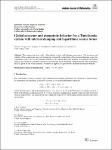Search
Author
- Carlos, Alegría (2)
- Carlos, Seara (2)
- David, Orden (2)
- Klaus, Bretterbauer (2)
- next >
Subject
Date issued
Has File(s)
- true (287)
Search Results
This manuscript deals with a Timoshenko system with damping and source. The existence and stability of the solution are analyzed taking into account the competition of the internal damping versus the logarithmic source. We use the potential well theory. For initial data in the stability set created by the Nehari surface, the existence of global solutions is proved using Faedo–Galerkin’s approximation. The exponential decay is given by the Nakao theorem. A numerical approach is presented to illustrate the results obtained. |
We are interested in the McKay quiver Γ(G) and skew group rings A ∗G, where G is a finite subgroup of GL(V ), where V is a finite dimensional vector space over a field K, and A is a K −G-algebra. These skew group rings appear in Auslander’s version of the McKay correspondence. In the first part of this paper we consider complex reflection groups G⊆GL(V) and find a combinatorial method, making use of Young diagrams, to construct the McKay quivers for the groups G(r,p,n). We first look at the case G(1,1,n), which is isomorphic to the symmetric group Sn, followed by G(r,1,n) for r > 1. |
Given a subfield F of C, we study the linear disjointess of the field E generated by iterated exponentials of elements of F¯¯¯¯, and the field L generated by iterated logarithms, in the presence of Schanuel’s conjecture. We also obtain similar results replacing exp by the modular j-function, under an appropriate version of Schanuel’s conjecture, where linear disjointness is replaced by a notion coming from the action of GL2 on C
. We also show that for certain choices of F we obtain unconditional versions of these statements. |
We construct extremal metrics on the total space of certain destabilising test configurations for strictly semistable Kähler manifolds. This produces infinitely many new examples of manifolds admitting extremal Kähler metrics. It also shows for such metrics a new phenomenon of jumping of the complex structure along fibres. |
In this paper, we prove homological stability results about orthogonal groups over finite commutative rings where 2 is a unit. Inspired by Putman and Sam (2017), we construct a category OrI(R) and prove a local Noetherianity theorem for the category of OrI(R)-modules. This implies an asymptotic structure theorem for orthogonal groups. In addition, we show general homological stability theorems for orthogonal groups, with both untwisted and twisted coefficients. |
In this paper, we address the problem of optimal dividend payout strategies from a surplus process governed by Brownian motion with drift under a drawdown constraint, i.e., the dividend rate can never decrease below a given fraction a of its historical maximum. We solve the resulting two-dimensional optimal control problem and identify the value function as the unique viscosity solution of the corresponding Hamilton–Jacobi–Bellman equation. We then derive sufficient conditions under which a two-curve strategy is optimal, and we show how to determine its concrete form using calculus of variations. We establish a smooth-pasting principle and show how it can be used to prove the optimality of two-curve strategies for sufficiently large initial and maximum dividend rates. |
The paper considers the problem of unique recovery of sparse finite-valued integer signals using a single linear integer measurement. For l-sparse signals in Zn, 2l |
An optimal control problem associated to the Keller–Segel with logistic reaction system is studied in 2D domains. The control acts in a bilinear form only in the chemical equation. The existence of an optimal control and a necessary optimality system are deduced. The main novelty is that the control can be rather singular and the state (cell density u and the chemical concentration v) remains only in a weak setting, which is not usual in the literature. |
The paper describes a work of geometric analysis, shape interpretation, and algorithmic modeling on the intradossal conformation of compound vaults inside Palazzo Grosso by Vittone. The tools of VPL allow to confront vocabularies and rules of three-dimensional homogeneous objects, to be applied to ideal models and built architecture. |
We organize the modified trace theory with the use of the Nakayama functor of finite abelian categories. For a linear right exact functor Σ on a finite abelian category M, we introduce the notion of a Σ-twisted trace on the class Proj(M) of projective objects of M. In our framework, there is a one-to-one correspondence between the set of Σ-twisted traces on Proj(M) and the set of natural transformations from Σ to the Nakayama functor of M. Non-degeneracy and compatibility with the module structure (when M is a module category over a finite tensor category) of a Σ-twisted trace can be written down in terms of the corresponding natural transformation. |










